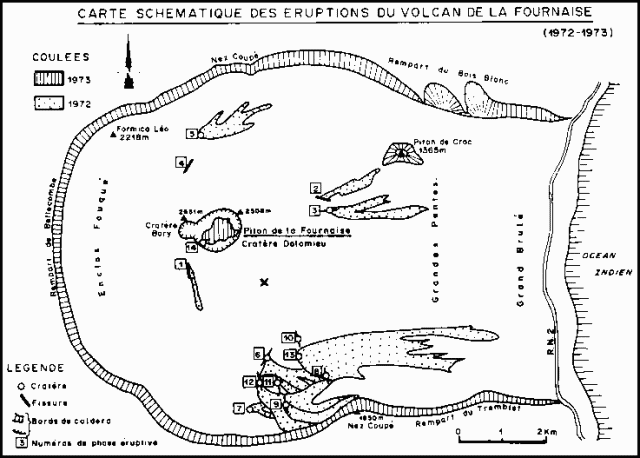Report on Piton de la Fournaise (France) — May 1979
Scientific Event Alert Network Bulletin, vol. 4, no. 5 (May 1979)
Managing Editor: David Squires.
Piton de la Fournaise (France) Small lava eruption, lasting less than 1 day
Please cite this report as:
Global Volcanism Program, 1979. Report on Piton de la Fournaise (France) (Squires, D., ed.). Scientific Event Alert Network Bulletin, 4:5. Smithsonian Institution. https://doi.org/10.5479/si.GVP.SEAN197905-233020
Piton de la Fournaise
France
21.244°S, 55.708°E; summit elev. 2632 m
All times are local (unless otherwise noted)
A small eruption began during the evening of 28 May and ended about noon the next day. A 100-m-long fissure opened ~1.5 km SE of Cratère Dolomieu, extruding a lava flow 150 m in length (figure 5). Three spatter cones formed on the fissure.
 |
Figure 5. Map of the caldera of Piton de la Fournaise from Krafft and Gerente (1977). The approximate site of the May 1979 activity is indicated by an X. |
Geological Summary. Piton de la Fournaise is a massive basaltic shield volcano on the French island of Réunion in the western Indian Ocean. Much of its more than 530,000-year history overlapped with eruptions of the deeply dissected Piton des Neiges shield volcano to the NW. Three scarps formed at about 250,000, 65,000, and less than 5,000 years ago by progressive eastward slumping, leaving caldera-sized embayments open to the E and SE. Numerous pyroclastic cones are present on the floor of the scarps and their outer flanks. Most recorded eruptions have originated from the summit and flanks of Dolomieu, a 400-m-high lava shield that has grown within the youngest scarp, which is about 9 km wide and about 13 km from the western wall to the ocean on the E side. More than 150 eruptions, most of which have produced fluid basaltic lava flows, have occurred since the 17th century. Only six eruptions, in 1708, 1774, 1776, 1800, 1977, and 1986, have originated from fissures outside the scarps.
Information Contacts: M. Krafft, Cernay.

